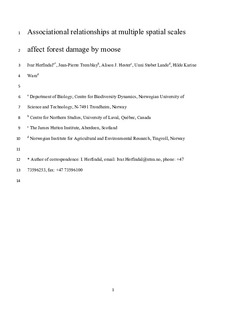| dc.contributor.author | Herfindal, Ivar | |
| dc.contributor.author | Tremblay, Jean-Pierre | |
| dc.contributor.author | Hester, Alison J. | |
| dc.contributor.author | Lande, Unni Støbet | |
| dc.contributor.author | Wam, Hilde K | |
| dc.date.accessioned | 2017-12-07T08:18:56Z | |
| dc.date.available | 2017-12-07T08:18:56Z | |
| dc.date.created | 2015-04-20T15:45:49Z | |
| dc.date.issued | 2015 | |
| dc.identifier.citation | Forest Ecology and Management. 2015, 348 97-107. | nb_NO |
| dc.identifier.issn | 0378-1127 | |
| dc.identifier.uri | http://hdl.handle.net/11250/2469469 | |
| dc.description.abstract | Increasing abundance of large herbivores combined with changes in forestry practices has led to increased forest damage in many temperate and boreal forest areas. The role of alternative forage as a driver for browsing pressure on tree species important for forestry has received increased attention. However, actions to reduce damage through altering forage abundance must be carried out at spatial scales that correspond to the behavioural processes that generate the browsing pattern. We used a multi-scaled dataset on browse abundance and utilisation in Southern Norway to assess how pine browsing damage was related to abundance and quality of browse measured at different spatial scales. Pine trees had a lower probability to be browsed at high pine abundance at all spatial scales. However, the abundance and quality of alternative browse was negatively related to pine browsing (i.e. associational resistance) at several spatial scales, with the highest explanatory power at the largest spatial scale. Management actions to reduce pine browsing by moose should focus on facilitating high abundance of both pine and alternative high-quality browse, and should be carried out at sufficiently large spatial scales (moose home range scale or larger). | nb_NO |
| dc.language.iso | eng | nb_NO |
| dc.publisher | Elsevier | nb_NO |
| dc.rights | Attribution-NonCommercial-NoDerivatives 4.0 Internasjonal | * |
| dc.rights.uri | http://creativecommons.org/licenses/by-nc-nd/4.0/deed.no | * |
| dc.title | Associational relationships at multiple spatial scales affect forest damage by moose | nb_NO |
| dc.type | Journal article | nb_NO |
| dc.type | Peer reviewed | nb_NO |
| dc.description.version | acceptedVersion | nb_NO |
| dc.source.pagenumber | 97-107 | nb_NO |
| dc.source.volume | 348 | nb_NO |
| dc.source.journal | Forest Ecology and Management | nb_NO |
| dc.identifier.doi | 10.1016/j.foreco.2015.03.045 | |
| dc.identifier.cristin | 1238153 | |
| dc.relation.project | Norges forskningsråd: 215647 | nb_NO |
| dc.relation.project | Norges forskningsråd: 223257 | nb_NO |
| dc.description.localcode | © 2015. This is the authors’ accepted and refereed manuscript to the article. This manuscript version is made available under the CC-BY-NC-ND 4.0 license http://creativecommons.org/licenses/by-nc-nd/4.0/ | nb_NO |
| cristin.unitcode | 194,66,10,0 | |
| cristin.unitname | Institutt for biologi | |
| cristin.ispublished | true | |
| cristin.fulltext | postprint | |
| cristin.qualitycode | 1 | |

